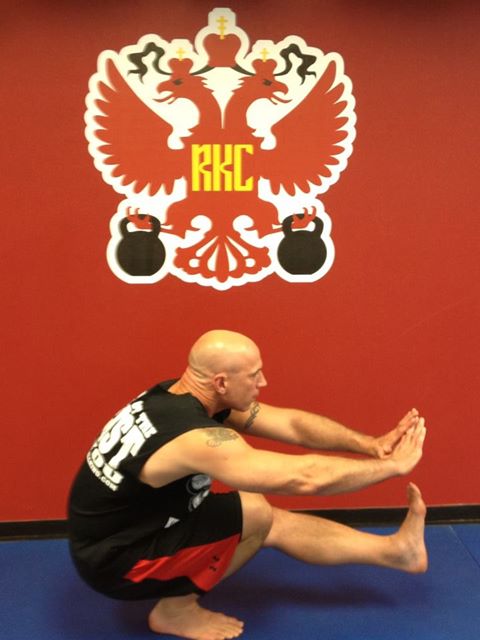The Pistol (Single Leg Squat): The most difficult and beneficial leg exercise – period. The training enroute a butt to heel Pistol develops balance, trunk stability and incredible leg strength. There are weight lifters that can full squat 500 to 600 pounds, yet they collapse and fall over when attempting the Pistol.
Let me relay a little story to you. I was cornering at a UFC Event in Houston in 2011 and went out for a bit of R & R before the fight, once my fighter was in bed. As a typical occurrence, the supporting fight team trainers and coaches usually run into each other and discuss their “Trade Secrets” and training methods. As it happened, I ran into a couple of other trainers in a local watering hole (that’s another name for a bar incase the younger crowd is wondering what I’m talking about.) So I’m talking to a couple of the other trainers and we strike up a conversation about strength training, what works best, how we train, etc… Our conversation moves onto squats. Now both of these guys were around 30 years old and are built like brick outhouses. They could both squat in excess of 600 lbs, but were not overweight or disproportionate. We started talking about the one-legged squat (Pistol) and I proceeded to demonstrate a few of them. They, of course, had to try and promptly fell over – on every attempt. Not a clean pistol performed between the both of them. I now had their attention.
The balance, core strength and overall athletic development gained from performing the Pistol are incomparable. In most athletic events (even in walking!) you are placing all of your weight on one foot and then the other. When you make a “cut” on the field, quickly hop from one side to the other or have to scale a deep incline, your stabilizers, tendons and and core are continuously firing. Pistols, much more than machines or bilateral, two legged exercises, increase your strength more efficiently.
As far as injury prevention, the development of the synergy with these muscles of the leg – all at once – is incredible. I experienced a trilateral break o my left leg which resulted in 10 screws and a 5″ plate being installed. I used Pistols as part of the rehabilitation process. I realize that whole industries have been built and billions spent on leg muscle “isolation” machines. However, when you walk, perform a task or athletic event – do you ever isolate your gastrocs, quads or hammys? The answer is a resounding “No”. Unless you’ve experienced some type of injury to a specific area, you will be creating asymmetries by muscle isolation. If you have a leg extension/hamstring machine, do yourself favor and sell it for scrap metal and practice your Pistols!
So, how do we achieve the proper execution of this Ultimate Leg Exercise? You need to employ progressions and at times, regressions. This exercise, up to a certain weight, is more easily achieved with a kettlebell. The counter weight aides your downward momentum. One of the best books on the subject is Coach Paul Wade’s Convict Conditioning: http://www.dragondor http://www.dragondoor.com/?apid=4640 & visit products/books. The progressions enroute achieving the Pistol are the best available.
To start your Pistol Training, you must first be able to perform narrow stance squats. Once you are able to do 20 or so, you are ready to attempt shifting the weight from two legs to one. I believe the best methods to improve your Pistol is with both Top Down and Bottom Up motions. Maintaining tension throughout the full range of the movement is tantamount, especially at the bottom of the Pistol. That is the point where most people lose their tension and collapse. Go down into a full narrow stance squat and thrust one foot forward and then go up. Be sure to stomp your Pistol foot into the ground and drive your power through the heel of the unweighted leg. Grunting and focused hissing, especially when you are first learning, is very helpful. Again, creating and maintaining the tension throughout the whole movement is essential. For the Top Down training – employ the use of a bench and once your buttocks touches the bench, EXPLODE Upward. When practicing the Bottom Up training, use a rope or band thrown over a high bar. While you improve, you’ll have to use your arms less and less to help you come out of the bottom position. There are also a variety of steps explained thoroughly in Coach Paul Wades Convict Conditioning book. Once you start to develop the ability to perform the Pistol, do it from a raised platform so that your unweighted leg does not have to be held so high. When you can perform 5 or more on a raised platform, you are ready to try a Pistol from the floor. The actual amount of repetitions before you are ready to move to the next step may vary from individual to individual. However, the numbers listed are good guidelines.
There are more advanced levels of the pistol as well. One or two hands raised in the air adds an element of difficulty and makes the Pistol a truly Elite Movement. You may add weight. It is true that a smaller kettlebell makes performing the movement a bit easier, but once you start increasing the weight or use two kettlebells or a barbell, then you have significantly increased the difficulty of the movement.
***
About Master RKC Phil Ross: Master RKC, 8th Degree Black Belt, Specialist in Bodyweight Strength, PCC and CK-FMS Certified. His name is synonymous with Martial Arts and Fitness. He is known as the area’s Kettlebell King and has successfully competed on the National Level in… Read more here.
